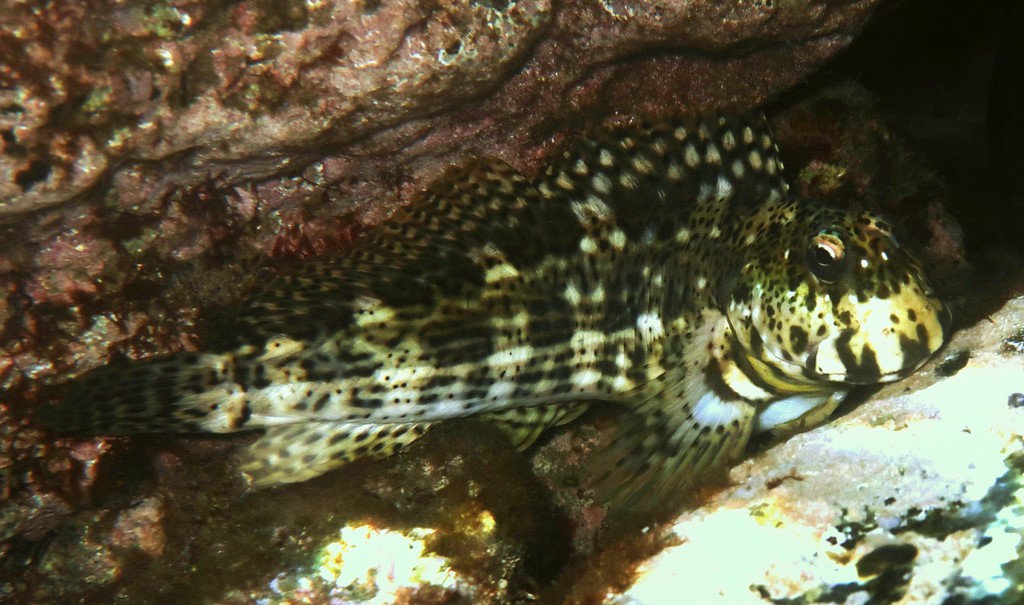ENTOMACRODUS DECUSSATUS - (BLEEKER, 1858)
Picture courtesy of: Alain Daoulas
Actinopterygii (Gigaclass) > Actinopteri (Class) > Teleostei (Subclass) > Blenniiformes (Order) > Blennioidei (Suborder) > Blenniidae (Family) > Salariinae (Subfamily) > Entomacrodus (Genus)
Wavy lined blenny, Wavy-lined blenny, Kikai-kaeru-uo, キカイカエルウオ, 斑紋犁齒鳚, 斑紋間頸鬚鳚,
Synonymes
Entomacrodus aneitensis (Günther, 1877)
Entomacrodus anietensis (Günther, 1877)
Salarias aneitensis (Günther, 1877)
Salarias atkinsoni (Jordan & Seale, 1906)
Salarias decussatus (Bleeker, 1858)
Salarias kikaiensis (Aoyagi, 1954)
------------------------------
Descritpion
Dorsal spines (total): 13; Dorsal soft rays (total): 16-18 (rarely: 18); Anal spines: 2; Anal soft rays: 16-19 (rarely: 16). Posteriormost anal pterygiophore supporting: 1-2 (usually: 2) external elements; Total gill rakers on first arch: 17-30, tending to increase in number with increase in SL; Pseudobranchial filaments: 5-17, tending to increase in number with increase in SL; Vertebrae: 34-36 (usually: 35); Supraorbital cirri: 1-28, increasing in number with increase in SL; Main, or longest, supraorbital cirrus with many short branches on both mesial and lateral margins; Nape with 1 cirrus on each side (frequently with small side branches in specimens over 55 mm SL); Predorsal commissural pores 3 to more than 50, increasing in number with increase in SL; Preopercular series of pores varying from all positions with simple pores to all positions with pairs or multiples of pores (specimens less than 40 mm SL frequently with all positions with simple pores; specimens over 90 mm SL have at least 1 pair of pores included in the series); 1-2 (rarely: 3) pores before each anterior nostril; Lateral line pores terminating on side in area below and between dorsal ray 2 and caudal base (posterior terminus somewhat determined by size; Specimens less than 40 mm SL usually have last pore anterior to level of dorsal ray 11; Specimens more than 70 mm SL usually have last pore posterior to level of dorsal ray 10); Ventral margin of upper lip of specimens less than 80 mm SL usually partially (centrally) crenulate and partially entire (laterally); Lip of specimens over 80 mm SL frequently weakly but completely crenulate (crenulae difficult to count). Males develop slight modifications of the skin of the anal spines. These modifications appear in the form of fleshy distal extensions of the skin at the tip of the spine. Greatest development occurs on the second spine, which may become plicate at the tip. Max. length: 19.0 cm TL. Depth range: 0 - 3 m.
Color
There is considerable variation in color pattern of specimens, including individual, ontogenetic and geographic variations.
Specimens of 16-45 mm show indications of 5,5 to 6,5 pairs of irregular bands on the side of the body. The bands are usually broken into three portions: dorsal, middle, and ventral. The midportions of each pair of bands are usually fused and sometimes appear ringlike.
At about 50 mm SL specimens begin to exhibit indications of irregular undulating stripes that overlay, incorporate, and frequently obscure the bands. The striping is least obvious in specimens from the Vanuatu, which are marked with a sprinkling of fine dark spots and dashes covering the sides. Large specimens from all localities except the Gulf of Thailand, South China Sea, Montebello, and Tahiti have less than five diffuse dark spots dorsoanteriorly on the sides. Specimens from the other localities have numerous dark spots in that region. The upper lip varies from uniformly dusky to having three broad, dark bands separated by pale interspaces. At least the soft portion of the dorsal fin, and sometimes the caudal fin, bear a number of discrete dark pinstripes and dashes in specimens from the Vanuatu, Tau, Tutuila, Samoa, Tongatapu, and Niuafou Islands (the latter five islands are closely associated geographically). Specimens examined from the other localities have the dorsal and caudal fins marked with diffuse dark spots which may or may not appear as enlargements of portions of what might have been a basic pinstripe pattern. The spots are usually restricted to positions over the rays while the pinstripes and dashes are continuous across the rays or are restricted to the membrane between the rays.
Many specimens over 60 mm SL have two to three narrow, dark longitudinal stripes or bands on the anal fin. On close examination, all specimens are found to have these stripes but the area between the stripes is sometimes almost as dark as the stripes themselves and thus the pattern is obscured.
Etymology
Entomacrodus: from Greek, ento = inside, in + from Greek, makros = big + from Greek, odous = teeth. Referring to very large and recurved tooth on each side of interior lower jaw of Entomacrodus nigricans and/or to its “greatly developed” canine teeth.
decussatus: from Latin, decussō = decussated, to divide crosswise, arrange crosswise or mark with a cross. Referring to overlapping longitudinal and transverse bands on body, which create a net-like pattern on younger specimens.
Original description: Salarias decussatus Bleeker, 1858 - Type locality: western Belitung (Biliton) Island and Sangi (Sungihe) Island, Indonesia.
Distribution
Western Pacific: eastern Malaya (Malaysia) and Indonesia, east to Mariana Islands, Tonga and Samoa, north to Ryukyu Islands (Japan), south to Australia and New Caledonia.
Biology
Facultative air-breathing in the genus; Adults inhabit exposed shallow reef flats in the intertidal zone. Also found in surge reef margins. Oviparous, distinct pairing. Eggs are demersal and adhesive, and are attached to the substrate via a filamentous, adhesive pad or pedestal. Larvae are planktonic, often found in shallow, coastal waters.
Last update: 30, March 2024
